458th Bombardment Group (H)
Collision over Cromer
May 27, 1944

Crew 74 (pilot Curt Vogel) was assigned B-24H 42-95159 and named it Rough Riders II. They were able to complete four missions in this aircraft, but before they could apply the name and nose art, the ship was lost when another crew took it for a mission to Neunkirchen. On this day, May 27, 1944, the group was assembling over Cromer and had just completed a left turn and were making a right turn when the pilot of #159, 2Lt Howard Lobo, either did not or could not complete the turn rapidly enough and collided with another B-24 42-95183 of the 755th squadron, Briney Marlin piloted by 2Lt Lester Martin of Crew 71R. The impact tore the entire tail assembly from #159 and that aircraft was last seen spinning down into the under cast about five miles offshore into the North Sea. All ten men aboard were listed as MIA and later declared dead. Two bodies were recovered after washing ashore – those of the navigator and bombardier. This was their first mission.
Aboard Briney Marlin (#183) that day, as a fill in top turret gunner/flight engineer, was S/Sgt Chester R. Carlstrum, the tail gunner on Crew 74 (he was also qualified as a flight engineer). When the collision occurred, Martin rang the bail out bell. Carlstrum dropped down and opened the bomb bay and salvoed the bomb load. He then bailed out through the bomb bay. The tail gunner S/Sgt Wilbert Abshire, also a fill in crewman that day from Crew 75, bailed out from the tail section. In the few seconds between collision and the two men bailing out, the ship had lost several thousand feet of altitude. Martin was able to regain control and he rescinded his bail out order. The impact had bent about 6-8 feet of the right wing of Briney Marlin down at a 90° angle (see photos below). They radioed the control tower at Horsham and asked for instructions. Colonel Isbell took off in Ginny, the group’s P-47, in order to look over the B-24 from the air. He ordered Martin to point the aircraft out to sea and bail the crew out. Martin decided he had enough control and decided instead, to attempt a landing at base. Keeping the airspeed high, they were able to land without further incident. As they were over the North Sea when the accident happened, Carlstrum and Abshire were never found, and presumably drowned in the English Channel.
They are both listed at Cambridge on the Tablets of the Missing. The rest of Crew 74 did not fly that day. Carlstrum was on his 25th mission. Les Martin gives a lot of credit to Carlstrum for saving the plane that day. His quick action in releasing the bomb load is believed to have been one of the factors that helped Martin regain control of the aircraft.

Col Isbell in the group’s P-47 Ginny, taking a look at Martin’s aircraft
Photo: Chuck Gribi
Accident Report 44-5-27-518 Statements
DESCRIPTION OF ACCIDENT [42-95159]
On 27 May 1944, 0942, at 10,000 feet, 5 miles north of Cromer, B 24 H 42-95159, while in formation had an aerial collision with another A/C 42-95183, resulting in it’s own tail being torn off, it going into a spin, and a total loss of A/C and the crew into the sea.
The Pilot, Lt. LOBO, was evidently inattentive and unexpecting the formation to shift from a left turn to a right one. He was, it seems the only A/C in the high right element at the time. He overran the #2 ship of the low trail element #183 which was in position. Nothing is known of the extent of damage to this A/C #159, except various other aircraft crew members verify that its tail was torn off and that it went into a spin. One parachute was seen just before the A/C reached the 3000’ undercast. One body was identified after it washed ashore as the Navigator, 2D LT TOIVO J. MAKI. Nothing else is known at this station.
DESCRIPTION OF ACCIDENT [42-95183]
On 27 May 1944, 0942, at 10,000 feet, 5 miles north of Cromer, while in formation, two B 24 H A/C 42-95183 and 42-95159, had a mid-air collision causing a major wing-tip damage to the first A/C 183, which was over run by A/C 159, in a sudden turn of formation from left to right. A/C 183 was flying in position as #2 ship of low trail element. #159 flying in high right element came down and across slipping into A/C 183 causing severe damage to right wing. As 2 A/C broke away the pilot Lt MARTIN of 183, had difficulty in controlling ship at first and was afraid it was going into a spin, gave order for crew to bail out. Being able to get A/C under control in a few minutes gave another order for crew to stay with the ship. Upon finding that he could fly ship and control its actions he decided to keep crew aboard and bring ship in for landing. Two men had bailed out, the Engineer and Tail Gunner. The A/C returned to it’s base, AAF 123, and made a successful landing without further damage.
RAYMOND F. HEMRICH, 2D LT. 0-750385. AC. 755th Bombardment Squadron, 458th Bombardment Group (H). AAF Station 123, APO 558.
I was flying on the right wing of the lower left element. We were starting to turn to the right and we swung in toward the center of the formation. I seen two ships hit but only got a glance as I was busy. It seemed the wing of one ship hit the other on the tail section or that he drug his tail across the wing. I seen the tail section start to bend to one side and come completely off. The ship started a slow spiral dive to the left and passed close over the top of our ship. My men watched the damaged ship until it disappeared thru the clouds and reported seeing no one bail out.
(signed)
RAYMOND T. HEMRICH
2d Lt, AC.
ROBERT T. CRAIG, 2D LT. 0-712772, AC 755th Bombardment Squadron, 458th Bombardment Group, AAF Station 123, APO558. Navigator A/C 183.
At 0941 on a heading of about 60 degrees, I saw a silver B-24H skidding dangerously close to our aircraft. He had skidded below us off the right and seemed headed right into us so as to hit us abreast. I immediately hit the nose wheel door release and stood by to bail out as I heard the smack of the collision and felt a slight jar. I already had my chute on and didn’t immediately jump since the plane still seemed under control and I knew we were over water.
I retained the opinion that the mid-section of the adjacent aircraft sheared off the last 5-6 feet of our right wing and he then went under us to nudge our nose turret with his nose and fall off forward and down. The collision occurred at 0942 while the plane was engaged in a formation right turn. The collision occurred 5 miles north of Cromer above Splasher 5. After the crash I stood by to bail out if any unusual maneuver at all was detected. I then called the pilot and being unable to make contact tuned Buncher 15 on the radio compass and told him to do a 180 since we were headed out into the North Sea.
After making our way back over the field and talking to the pilot I was convinced that a safe landing could be made and hence proceeded to a station in the waist.
(signed)
Robert T. Craig
2d Lt. AC.
LESTER C. MARTIN, 2D LT. AC 0-813927, Pilot, A/C 183, 755th Bombardment Squadron, 458th Bombardment Group, AAF Station 123, APO 558.
I was flying ship #183 on the right wing of hole(?) element in Section I. We were forming at 10,000 feet at the time of the collision and had just started a right turn immediately upon completing a left turn. About thirty seconds after starting the right turn I heard my co-pilot shout and looked up to see a ship skidding into us from the right. I pulled my right wing up sharply and at about the same instant felt the collision. My ship started into a spin and I gave the order to bail out, the engineer and tail gunner leaving the ship immediately. The ship was brought under control within a few seconds after the crash and the rest of the crew was prevented from leaving the ship by my order over the inter-phone. After getting the ship under control I went into the waist, leaving the ship with my co-pilot and surveyed the damage. The only damage visible to me was about six feet of the right wing hanging in space. I decided then to bring the ship in and gave my men the choice of bailing out or staying with the ship for the landing and they did the latter. We circled the field, made a very wide pattern and a successful landing with no further damage to the plane or injury to the crew. The landing was made with half flaps and at an air speed of approximately 170 miles per hour.
(signed)
Lester C. Martin
2d Lt. AC.
S/Sgt Chester R. Carlstrum and S/Sgt Wilbert Abshire – KIA May 27, 1944
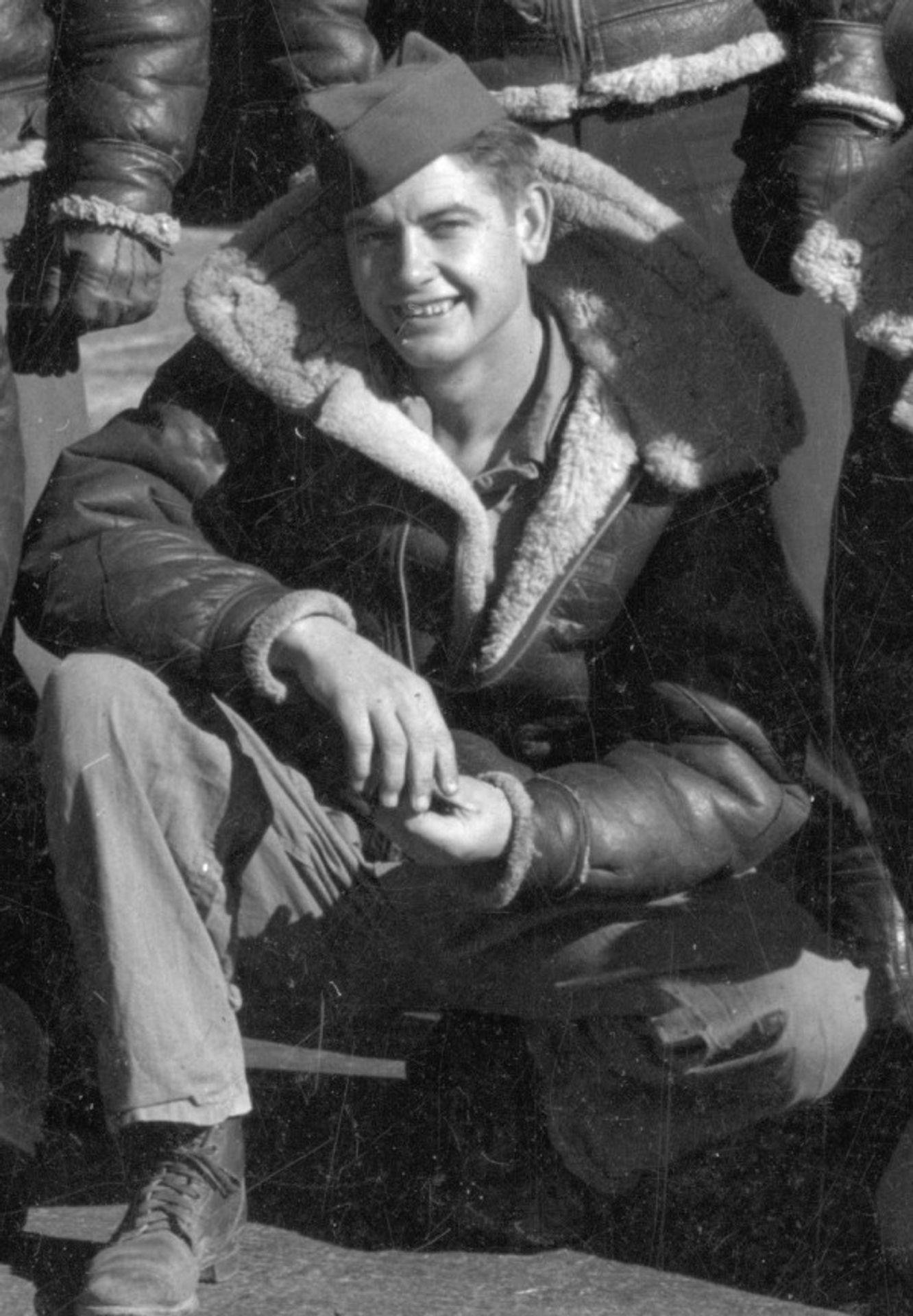
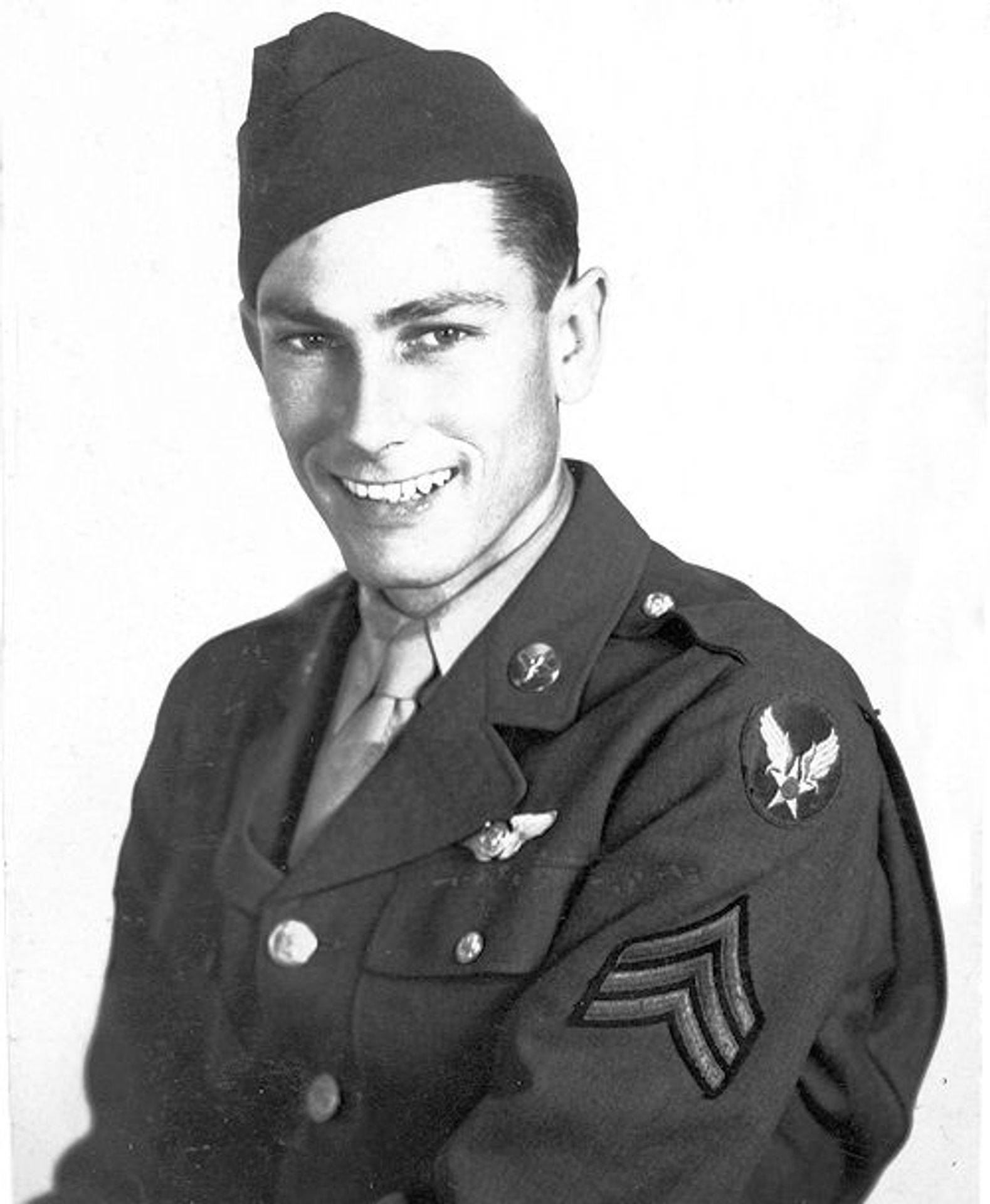
B-24H-25-FO 42-95183 Z5 U Briney Marlin
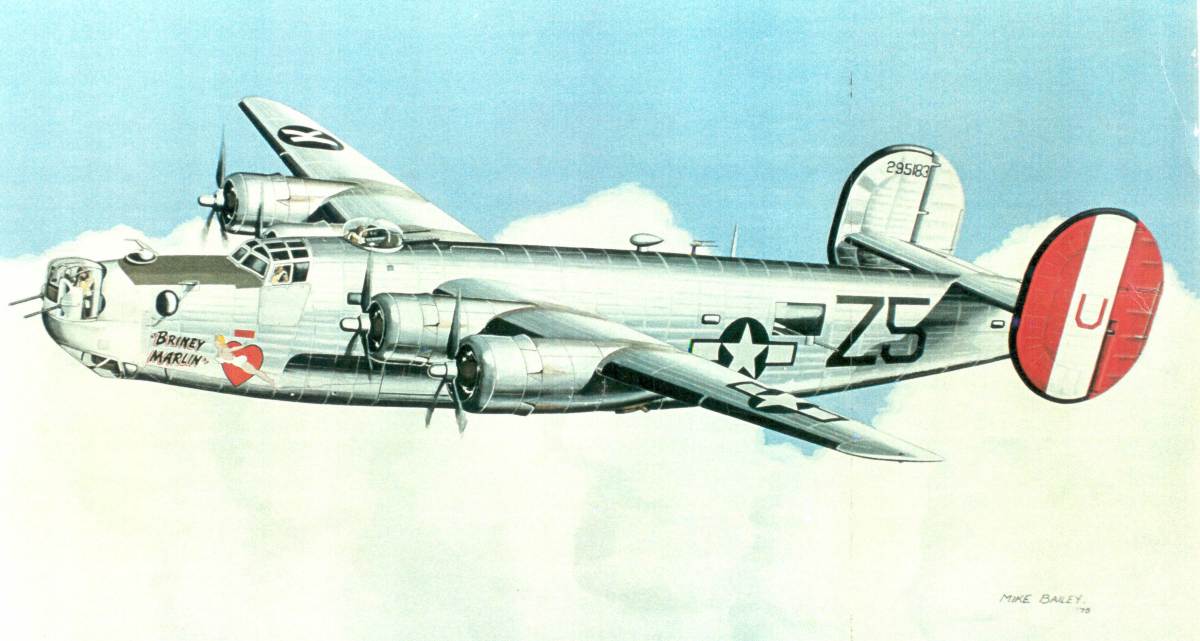
In front of barracks – Horsham St. Faith

Members of Crew 74: S/Sgt Chester R. Carlstrum – TG, 2Lt Allen C. Hilborn – CP, T/Sgt Joseph R. Brown – TTG/E
Photo: Allen Hilborn
Damage to Briney Marlin
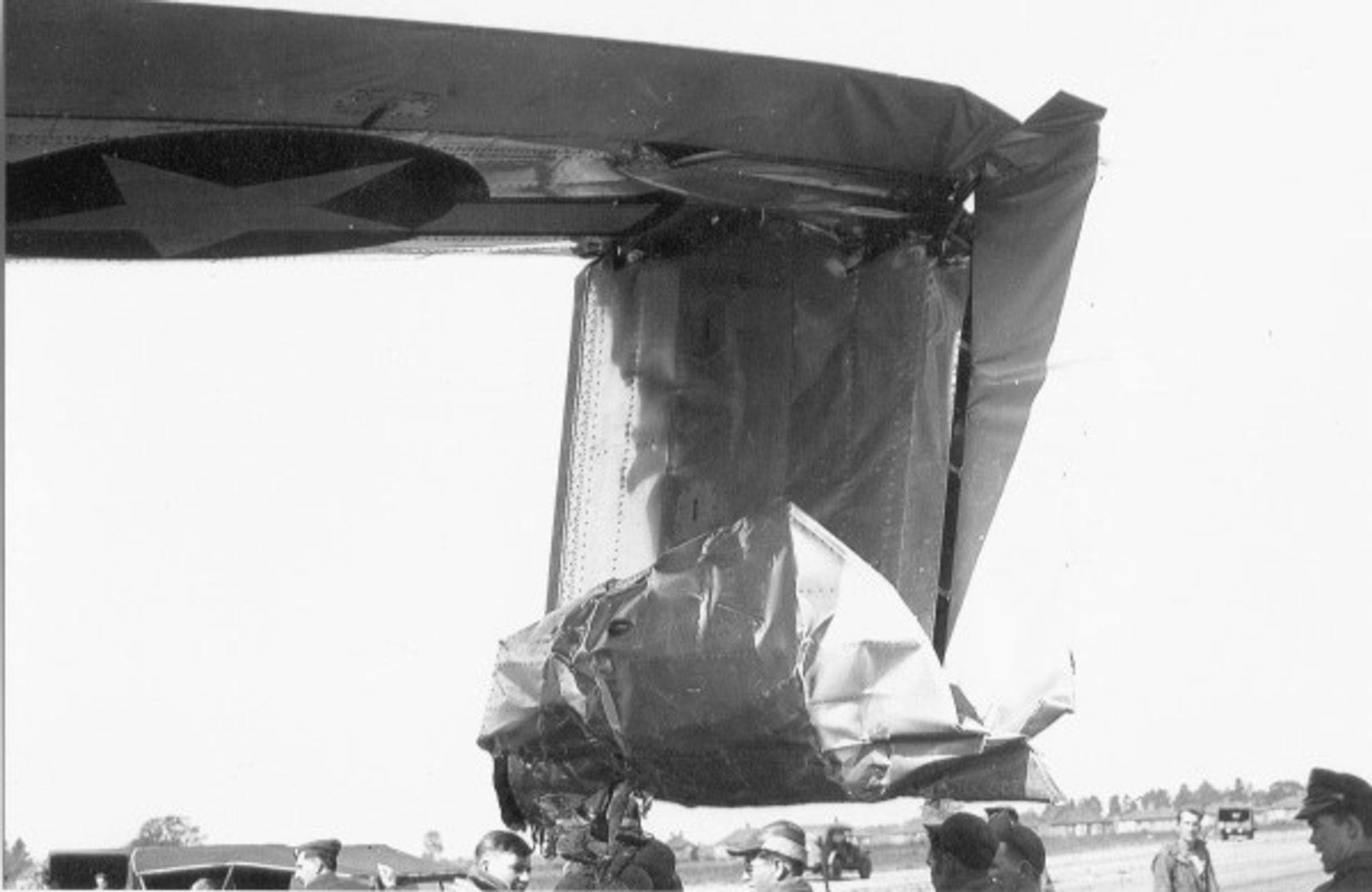
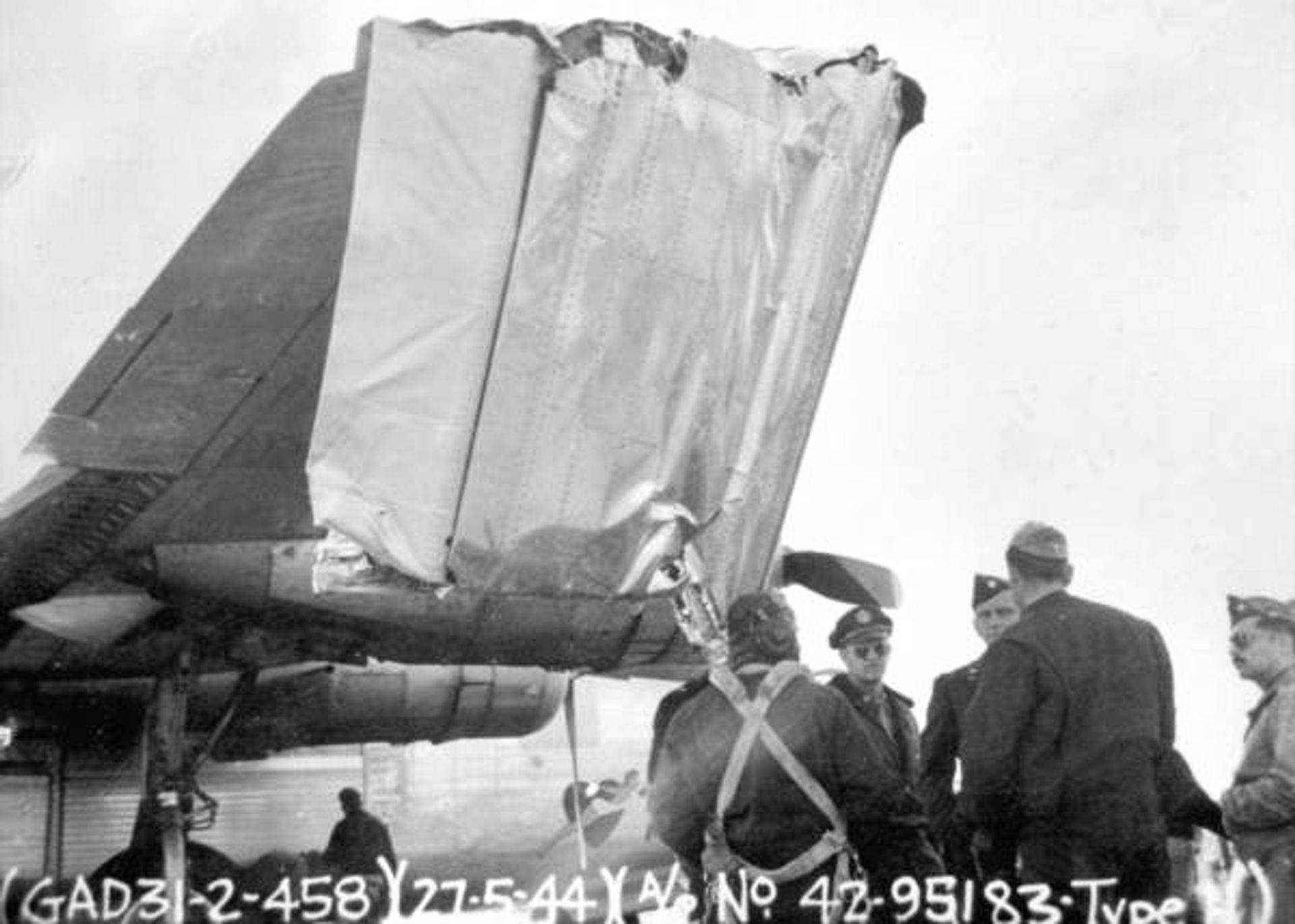
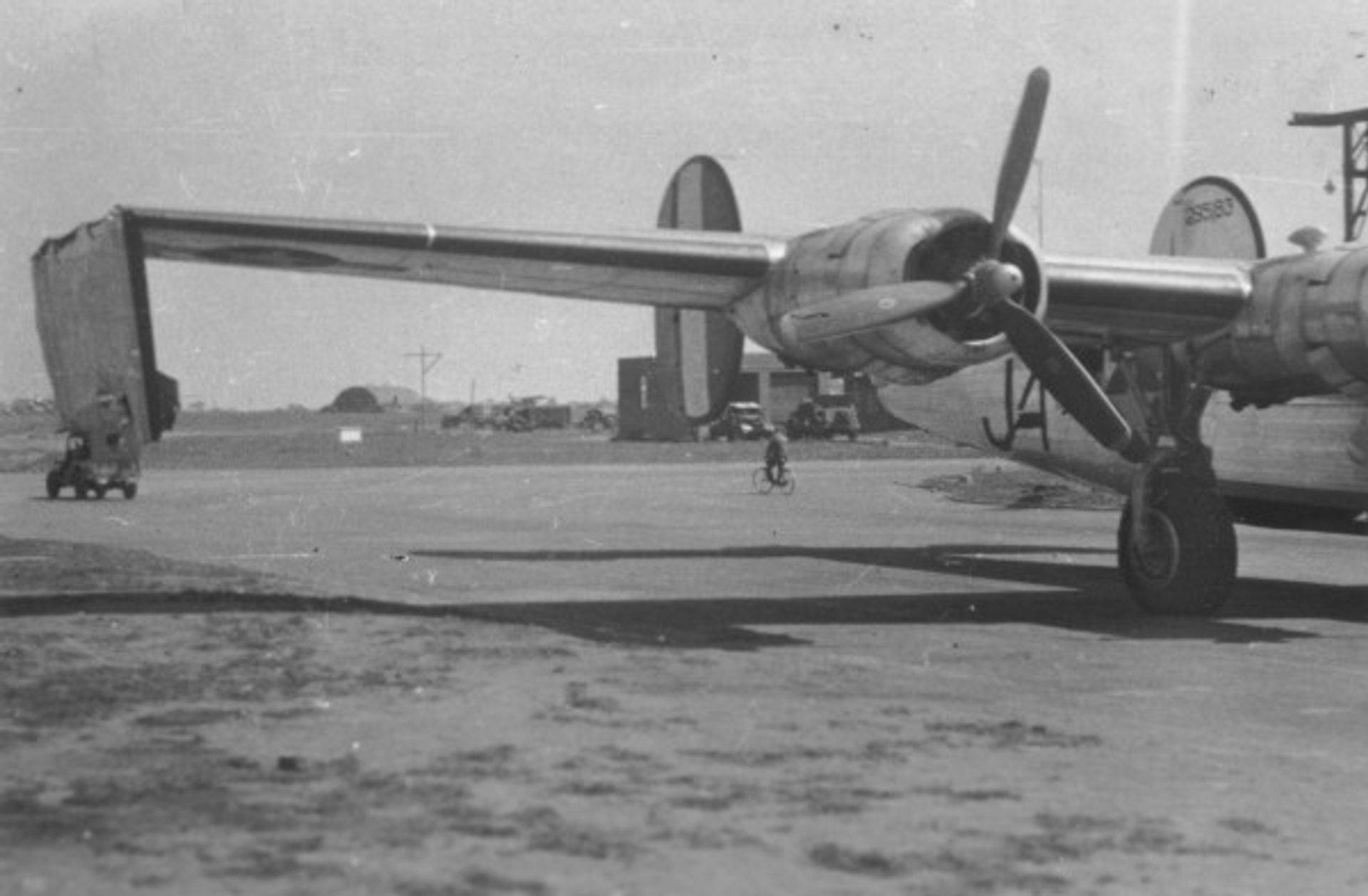
2Lt Lester C. Martin was awarded the DFC for bringing the plane down safely

1st Lt. Lester C. Martin wears the Distinguished Flying Cross as he stands beside the Consolidated B-24 Liberator Briney Marlin. Escorted by a Republic P-47 Thunderbolt, Lt. Martin brought his plane safely back to its base with seven feet of the wing (right) and aileron broken off and folded under following a collision with another bomber during assembly of a formation over the North Sea. Lt. Martin was cited for superior skill and courage in recovering his aircraft from a spin after the wing had been broken and left hanging, returning to base without further damage or injury to plane and crew.
General Orders No. 99 2BD Hq, 17 June 1944 – DFC CITATION
LESTER C. MARTIN, 0-813927, Second Lieutenant, Army Air Forces, United States Army. For extraordinary achievement, while serving as Pilot of a B-24 aircraft on a bombing mission to Germany, 27 May 1944. Lieutenant Martin’s aircraft collided with another B-24 as the formation was assembling over the North Sea. Seven feet of the right wing was broken and left hanging at a 60 degree angle, and the aircraft went into a spin. Lieutenant Martin courageously remained at the controls and with superior skill righted the aircraft, returning it to base without further damage or injury to the crew. The superior flying skill and cool courage demonstrated by Lieutenant Martin on this occasion reflect the highest credit upon himself and the Armed Forces of the United States. Entered military service from Alabama.
